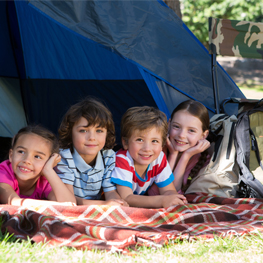
I grew up in a rural area, camping in the woods of our property and the back yards of neighborhood friends during the summer months. It was a rare night when any of us would sleep inside our homes, much preferring our companionship around campfires and being serenaded to sleep by the music of crickets, frogs, and the occasional owl.
I wanted this experience - to be able to commune with and embrace nature - for my four kids. My kids grew up, until recently, with a suburban, postage stamp-sized yard. How did we move from overnights in the fenced back yard to how we camp now as a family: primitive camping?
I took into account each of my kid’s concerns. Chief among their worries were spiders. Well, except for my youngest daughter, who told her dad and me time and again they were “her friends.” I showed my kids how to double-check the tent freeloaders and offspring waiting to hatch, paying particular attention to the seams and the corners for any lurkers. We patiently went over what constituted a fully zipped screen, which discouraged the creepy crawlies. Each of the kids zipped and re-zipped the screens as well as learning how to tie back the tent flaps.
When our kids were comfortable enough, we encouraged them to camp in the back yard without us, assuring them they should come inside if they needed us. Of course, we slept lightly.
I made a list of camp gear with my kids. Even the first-time camper needs gear in addition to the tent. I asked for each child’s input and we added their ideas, like a beloved stuffed animal and favorite snack to the essentials.
I taught my kids how to stay warm and dry. I believe a person is unlikely to camp again if they are physically uncomfortable the first time. Moisture and cold are often aspects of camping. Internal condensation happens, regardless of the tent. It occurs because each camper exhales roughly one litre of water as they sleep. I made sure that my kids understood the importance of leaving the rain fly open, which helps ventilation. I learned at a young age that it was not fun to be dripped on throughout the night, and being wet makes the camper colder. Also, I shared that lying up against the wall of a tent, no matter how warm the evening, invites moisture, or in the case of rain, invites water in.
Anything damp, such as socks, or wet stays outside the tent. Damp and wet promote condensation. My kids sleep with fresh dry socks on each night. On particularly humid nights, they change into dry, clean clothes or pajamas to ward off dampness. Having dry material against their bodies helps them retain heat. We place a doormat just outside of the tent flaps to put shoes and discarded socks on. My kids turn their shoes around so that they can slip right into them upon exiting the tent.
Despite warm temperatures outside, your little camper will become cooler because they are sleeping next to the ground. We made sure our kids had sleeping bags, which held their body heat. They could unzip their sleeping bag if they became too warm.
I went slow and steady. I wanted them to experience camping, so my husband and I started early, camping with them in the back yard when they were toddlers.
After we had observed our kids embrace the basics of camping out in our back yard, we expanded their camping skills and experiences and rented a campground. We added fire-making and fire safety, setting up and breaking down the campsite, hiking, basic First-Aid training, cooking over the campfire, and the washing of cooking pots and pans, dishes, and utensils.
At this point, we camp regularly, sometimes for up to a week. We augment it with fishing, kayaking, and sailing. Camping is wonderful bonding time for our family.
Judy savors time with her kids. She is a Certified Gottman Educator and the author of What to Expect From our Adopted Tween, Writing to Heal Adoption Grief: Making Connections & Moving Forward, and For Families and Friends: Advice, suggestions, and Honest Dialogue About How to Best Support Parents on Their Adoption Journey.
Calgary’s Child Magazine © 2024 Calgary’s Child